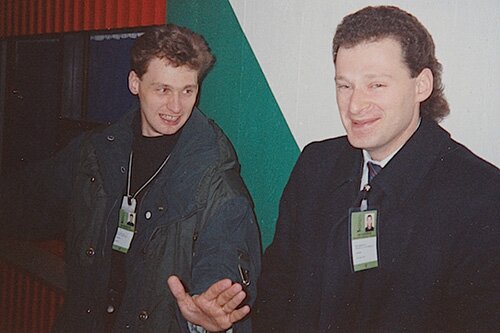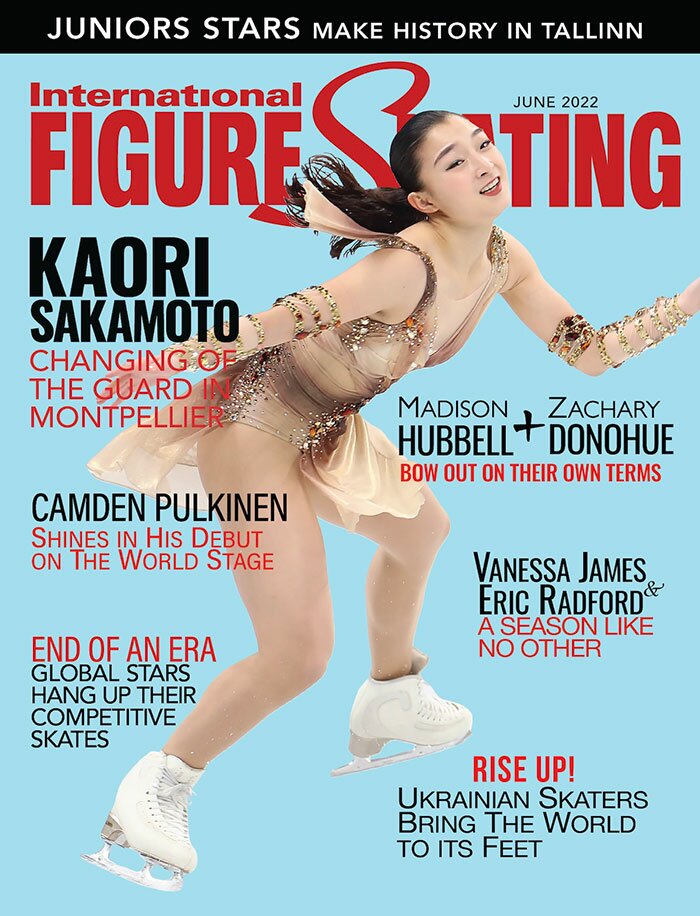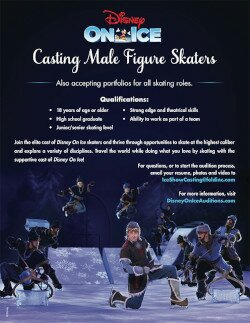
His name might not be familiar but the programs that Evgueni Nemirovski choreographed in the 1990s will be. Nemirovski was the creative force behind Viktor Petrenko’s 1992 Olympic repertoire and Oksana Baiul’s long program in 1994.
On any given Saturday morning, one can find Evgueni Nemirovski standing in the music box at the Dr. Pepper StarCenter in Euless, Texas. Despite the early hour, this is not Nemirovski’s first session of the day. He has already taught a 45-minute ballet class and an hour-long on-ice session at the StarCenter in Farmers Branch, Texas — a half hour drive from the Euless rink.
For someone who has choreographed programs for Olympic-level figure skaters, it might seem surprising that he now works with students at various levels. He said he would not have it any other way.
Nemirovski has been a fixture on the Dallas figure skating scene the last 14 years, but his story unfolded in a different creative space behind the Iron Curtain.
EARLY DAYS
Born in Odessa, Ukraine in 1958, his mother — a ballerina and later a teacher at the Odessa Ballet Theater — introduced Nemirovski to the world of dance. He quickly fell in love with it and joined the troupe, which was well respected not only Ukraine and the former Soviet Union, but also in Europe.
Nemirovski was a character dancer who performed many different styles. “My company did all types of traditional folk dances: Russian, German, Spanish, Jewish, and, of course, Ukrainian,” he said.
At the urging of his wife, who felt he might never make a good living with his dance career, Nemirovski enrolled in university. “She said that there simply was not enough money to live on with dance and suggested that I needed something else just in case I could no longer dance,” he said. “So, I went to university to become a mechanical engineer. Some of my very good friends from dance were going to the same university and I just decided to go with them.”
He continued to dance while he studied, but when he began working fulltime balancing his work and dance schedules became a problem. The dance troupe frequently went on tour, which required him to leave his job for extended periods of time. Nemirovski recalled that did not sit well with his employer.
“I had a lot of trouble with the administration. They did not like my schedule and they were very jealous because at that time it was very exciting to be allowed to travel. We had the Iron Curtain then and very few people got to leave the Soviet Union.”
GETTING CONNECTED
Odessa’s prominence in skating history is largely due to legendary coach Galina Zmievskaya. During the 1980s and early 1990s, Zmievskaya’s skating school put the city on the map as a figure skating hub in Ukraine.
Nemirovski’s mother worked with skaters at Zmievskaya’s school, conducting off-ice ballet and stretching classes initially. Over time she began working with skaters on the ice, eventually becoming the head choreographer.
Through his mother’s work, Nemirovski met Konstantin Vaypan, whose two sons, Serhii and Yuri, trained with Zmievskaya. Vaypan, who ran a factory in Odessa, was willing to accommodate Nemirovski’s dance schedule. “He helped and allowed me to find the time to work and dance. He was always very friendly and kind,” Nemirovski recalled. “If I needed to leave early for a rehearsal or if we had to go on tour, he was fine with my schedule.”
In 1985, a few of the coaches from Zmievskaya’s rink attended the ballet company’s annual recital. Their brief encounter with his world set his life on a new path. “Galina did not go to the recital, but the next day at the rink the ice dance coach kept going on about my performance,” Nemirovski said. “Galina was looking for a man to do some choreography for Viktor Petrenko and she decided to try working with me.”
A few days later, Nemirovski began working with Petrenko. He recalled Zmievskaya giving him a pair of boots and playing some music and he started dancing on the ice. “It was at the end of training and the ice was covered with snow and I just danced,” he said. “My start with figure skaters was very unexpected.”
Zmievskaya was happy with the program he created for Petrenko and invited him to work with her. But balancing his dance schedule, fulltime job and his new found coaching position became too much, and after a few months and Nemirovski decided something had to give. He quit his day job.
Despite Zmievskaya’s repeated requests, he would not give up his dance career and did not retire from the stage until 1992. “I had never thought about working with skaters before Galina’s offer. I always thought my life would be on the stage,” he said in retrospect.
Although his first venture into figure skating choreography with Petrenko was successful, the transition from ballet dancer to figure skating choreographer had its challenges. Nemirovski could not distinguish the different jumps and turns and had no idea what it felt like to glide and move on the ice. Zmievskaya suggested that he learn to skate.
“When I first danced on the ice most of my moves were more closely related to things I would do on the stage, not what the skaters would do on the ice,” he recalled. “I remember Viktor gave me a pair of his old skates and I started to learn the field moves, crossovers and eventually jumps and spins. I wasn’t very good, but my dance experience and knowledge of my body allowed me to progress very quickly.”
Three years later, Petrenko placed third at the 1988 Olympic Winter Games.
MOVING TO THE MUSIC
Heading into an Olympic season, Nemirovski said the choreographic process was the same as any other. Every year, at the end of May, Zmievskaya, her assistant coach Valentyn Nikolayev, Nemirovski and all the skaters would go to Dnepropetrovsk, a city in south central Ukraine.
Though there was often no ice at the rink there was a man who could cut music. “We would sit there all day listening to lots of music. Normally we would find music for six or seven kids each day — it was very slow,” Nemirovski recalled. ”We didn’t go into an Olympic season with a specific piece of music in mind. We didn’t pick the music for the Olympic Games — we picked the music for where the skater was at that point in time.”
Once the music had been selected Nemirovski would begin working with the skaters on the floor so they would learn how to move to the music. They would then transition the movements and steps onto the ice.
The process was the same whether he was working with Petrenko or a young, lower level skater. “When a program is born it is just a skeleton and then after you try to add meat to it, more muscle and it is constantly growing. It is like when you have a child and you buy them new pants and in a few months you notice that the pants are too short and a bit tight. The same thing happens with a program. Some parts work very well and others, after two weeks even, are no longer comfortable.”
In some instances this meant that whole programs were scrapped and new ones were created. One such instance was a program Nemirovski created for Petrenko that was set to music from the Broadway musical “Chess.” Despite the program being one of Nemirovski’s favorites, Petrenko never performed it. “Some of the movements were uncomfortable for him so we just decided to change the whole program,” Nemirovski said.
One of the things he said he loved best about working with Petrenko was his willingness to try new styles. “At one point people described Viktor as a ‘romantic skater’ because most of his programs were full of nice slow movements. After that Viktor wanted to try something new so started working with some rock and roll music.
“We did ‘Let’s Twist Again’ by Chubby Checker for a show but nobody believed that he could do it. I even thought it would be very difficult. We spent many hours on the ice and even more on the floor just dancing with the music and then all of a sudden this number appeared at a show and everyone was shocked.”
Despite winning an Olympic title and eventually becoming a seasoned show skater, Nemirovski felt that performing did not come easily for Petrenko. He recalled putting in many hours on and off the ice each week with Petrenko to ensure that his performance level was on par with his technical ability.
“Viktor was not naturally gifted, but he was an incredibly hard worker. For the audience and myself, a competition is the same as a show. Yes, the skaters are competing with each other, but for me it is more like a dancing competition.
“If you can’t do the jumps then you won’t be on the top of the podium, but those errors can be fixed. In my opinion, people come to watch a figure skating competition because they want to see something beautiful — they want to be made to feel something and that is difficult to do.
“One of my favorite programs that I did was Viktor’s free program to Jules Massenet’s “Le Cid.” It was very beautiful — very gentle, very graceful. It suited him perfectly, just like his “Carmen” short program from the 1992 Winter Olympics.”
Petrenko’s long program to “Light Cavalry Overture” by Franz von Suppe also stands out in Nemirovski’s memory as one of his best programs.
With Baiul, however, his work as a choreographer was a little easier. “Oksana enjoyed dancing in many different styles, so we had no limitations in the music choices. It was always very easy,” Nemirovski recalled. “She didn’t come to us until she was older. I didn’t know her at all but I remember that the first day she came to rink, Galina had me do a ballet class with her. I started the class and I could see how flexible and delicate she was with her movements.”
Nemirovski choreographed several competitive programs and show numbers for Baiul, including her 1994 Olympic free program, set to a medley of Broadway show tunes, but the “Swan Lake” short program was choreographed by one of the ballerinas from the Odessa Ballet Theater.
“Galina wanted a lady who had performed this ballet,” Nemirovski said. “I could have shown Oksana things to do, but it would not have been as authentic. There were so many small details that I would have missed. We worked throughout the season, polishing the program…I added a few arm movements.”
Though he was satisfied with many of the programs he choreographed for Baiul, her show number to the “Chicago” soundtrack is by far his favorite.
“I was very happy with that program because Oksana told me that after she had performed it in a show in the U.S., she got a phone call from Madonna, saying that she loved the program. I was so happy and proud of myself.”
BEYOND THE CURTAIN
Despite the role Nemirovski played in the Olympic victories of both Petrenko and Baiul, he did not attend either competition. He rarely accompanied skaters to international events, but always tried to find the competitions on television. He recalled sitting in his living room watching Petrenko and Baiul compete at their respective Olympic Games. “It was difficult watching on the TV. I was very nervous. I don’t understand why some people think I shouldn’t be nervous when my skaters compete,” Nemirovski said. “They think I just have to worry about arm movements and things, but it is a big deal for me. Figure Skating is not only a sport, but also an art. It should be a show. I am responsible for my skaters and for their performance.
“When I was watching Viktor compete at the 1992 Olympics I was pretty calm. At his first Olympics in 1988 when he was third, I felt that he would be on the top in 1992. I knew how hard he had worked and I knew how much he wanted to be on the top. If he had to attempt something he had never done before in order to win I knew he would give it a try.”
Though Nemirovski was also confident in Baiul’s ability to win in 1994, he was more concerned that she lacked Olympic experience and was not a seasoned competitor as Petrenko was in 1992. But Baiul went out and exceeded all of Nemirovski’s expectations, winning the Olympic gold medal.
During this era, Nemirovski also worked with several of Zmievskaya’s other star pupils, including Vladimir Petrenko, Viacheslav Zagorodniuk and Michael Shmerkin.
After Petrenko’s 1992 victory and Baiul’s triumph in 1994, Nemirovski was invited to do clinics in many different countries, including Finland, South Korea, Austria, Slovakia, Germany and the Czech Republic.
These opportunities opened his eyes to the possibilities of a life and a career outside of Ukraine. This, coupled with the deteriorating conditions of the training facilities in Odessa, inspired him to relocate.
He was offered a full time position at the Helsinki Figure Skating Club, but turned it down, opting to stay in Ukraine to help care for his ailing mother.
However, in his heart, Nemirovski knew that in order to have a better life and a better chance to do what he loved, he would have to move.
“I really liked Germany and at that time Munich was my favorite city. Oberstdorf has a wonderful training facility and it is close to Munich so I thought it would be a good place,” he recalled.
Nemirovski had never considered the United States as an option but a conversation with Petrenko inspired him to look into it. “When Viktor came back from doing shows in the U.S., he came to my house and we were sitting in the kitchen talking about the future and he told me that it would be better for me if I went to the US. He thought that the level of figure skating in the U.S. was higher than in Europe.”
With Petrenko’s help, Nemirovski was offered an invitation to work at a club in Anchorage, Alaska — and would help him complete all the paperwork and obtain a work visa.
At the time, Sydne Vogel, the 1995 U.S. junior champion lived and trained in Anchorage and the club was hoping to bring in some new coaches and choreographers to work with her. Nemirovski and his wife moved to Anchorage in 1997 and remained there for two years.
“I started very quickly in Anchorage. I remember we arrived there on a Saturday night, on Sunday night we went to buy a car and on Monday I started working.”
Unfortunately, Nemirovski’s move to Alaska marked the end of his coaching relationship with Zmievskaya, who also relocated to the U.S., settling in Simsbury, Connecticut.
While Nemirovski enjoyed living and working in Anchorage, he found the long, dark, snowy winters difficult to deal with and when Vogel retired from competitive skating in 1999, he decided it was time to move. A phone call from a former student who was coaching in Omaha, Nebraska provided him with the opportunity he was looking for. “It was an kind of an accident that I ended up there,” Nemirovski recalled. “We had kept in touch and one day he called and asked if I knew of any good choreographers who would move to his rink to coach and I said ‘yes, me.’ He thought that his club was too small and that the skaters were at too low a level, but I didn’t care. When I started working with figure skaters I worked with the little kids as well as the older skaters. It keeps it fun and interesting.”
In May 1999, Nemirovski made the move to Omaha. He recalled that everything was green “but in Alaska in May it was still snowing!” He lived there for four years, coaching fulltime for the first two, but in 2001 began conducting seminars and choreographing programs around the U.S. “I would go into rinks and clubs for a few weeks in places like Kansas, Fairbanks or Dallas and work on programs with the skaters who were there, and then I would go on to the next,” he explained. “I had a very long relationship with the Salt Lake City Figure Skating Club. I used to go there seven or eight times a year.”
It has been 25 years since Petrenko won his Olympic title, and though none of Nemirovski’s students have since claimed Olympic medals, many have found success at different levels. Among his current clientele: 2017 U.S. junior champion Alexey Krasnozhon; Madison Nguyen, the 2017 U.S. juvenile girls champion; Stephanie Ciarochi, the 2017 U.S. intermediate champion, and Hanna Harrell.
Nemirovski said if none of his programs ever again reach the top step of an Olympic podium, he will be OK with that. “I fell in love working with figure skaters because I could see the results. I got to teach people how to perform. Not everyone is a great performer. It is so much fun when you have a student who isn’t very good at first, but then after a few years becomes an incredible performer.”
His love of the choreographic process is what has kept Nemirovski going the past three decades. “Every time I choreograph a new program I want it to be better than anything else I have ever done,” he said with a smile. “My desire to create more interesting programs has kept me doing choreography for all these years. It is a challenge.
“It is very rare that I am really happy with a program — I don’t care if judges or other people don’t like it. If it is exactly what I imagined it to be then I am happy. I realize that there must be something wrong if other people don’t like it; however, I still know that it is a good program. But, most of the time there is always something that could be better.”




